Abstract
The distribution and chemical behavior of Cd2+ in tissues and its chemical form in xylem water of soybean plants (cv. Williams) were investigated. Following root absorption, Cd is strongly retained by roots, with only 2% of the accumulated Cd being transported to leaves; as much as 8% was transported to seeds during seed filling. In vivo xylem exudates contained two anionic Cd complexes in addition to inorganic forms of Cd. Once accumulated in root and leaf tissues, Cd rapidly equilibrated between the insoluble, soluble, and organelle fractions. Of the solubles, which contain 50% of the Cd, >50% was associated with components of >10,000 molecular weight, and <8% was associated with <500 molecular weight components. Cadmium accumulated in soybean seeds was primarily associated with cotyledons. Fractionation of seeds showed the soy proteinate and soy whey to contain 32 and 50% of the accumulated Cd, respectively.
Full text
PDF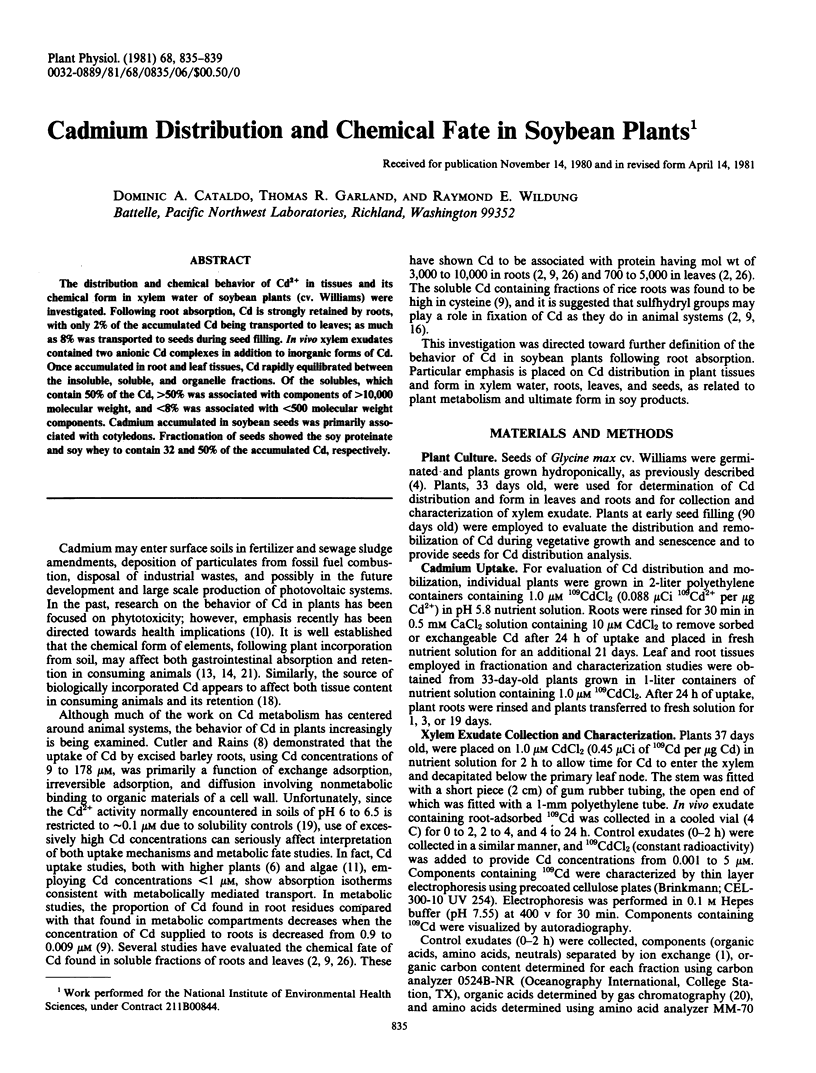
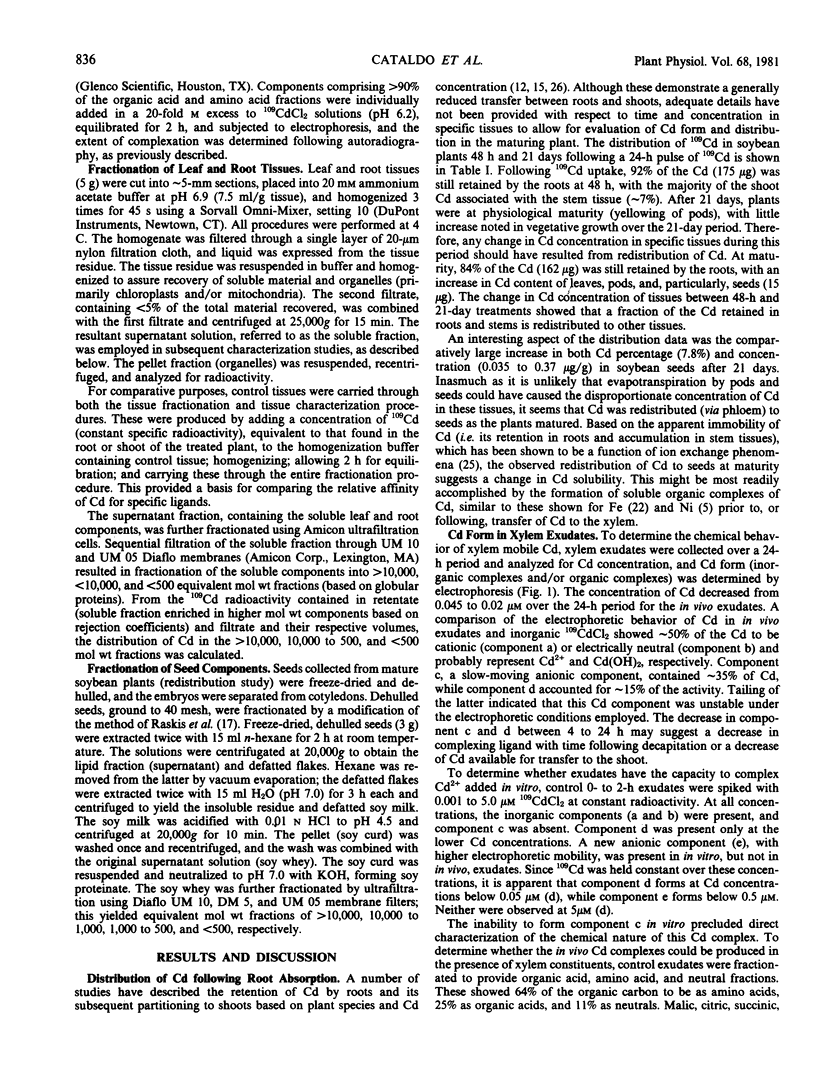
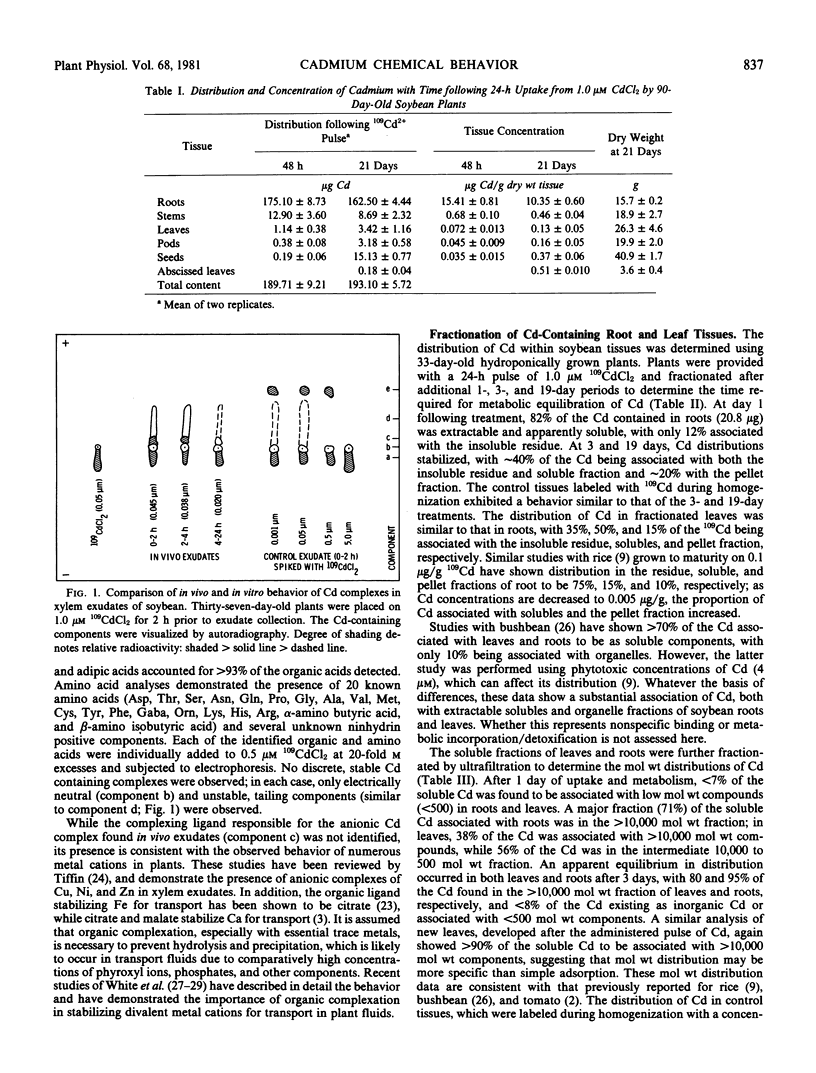
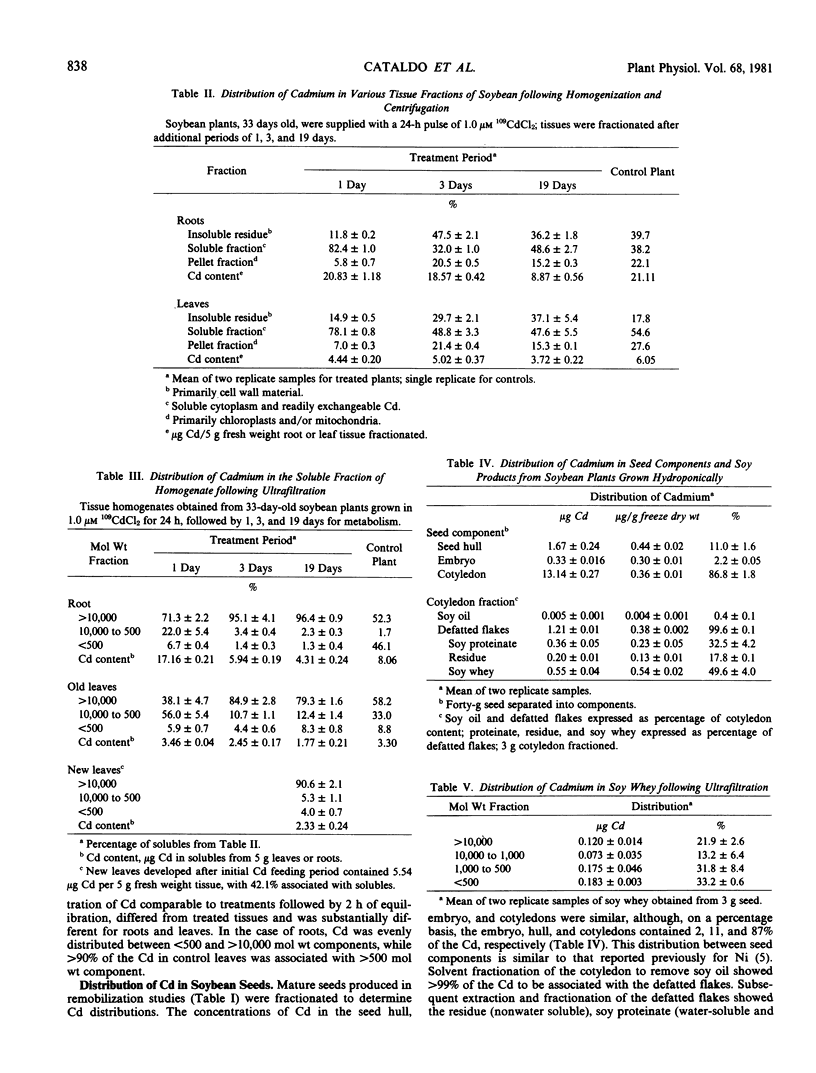
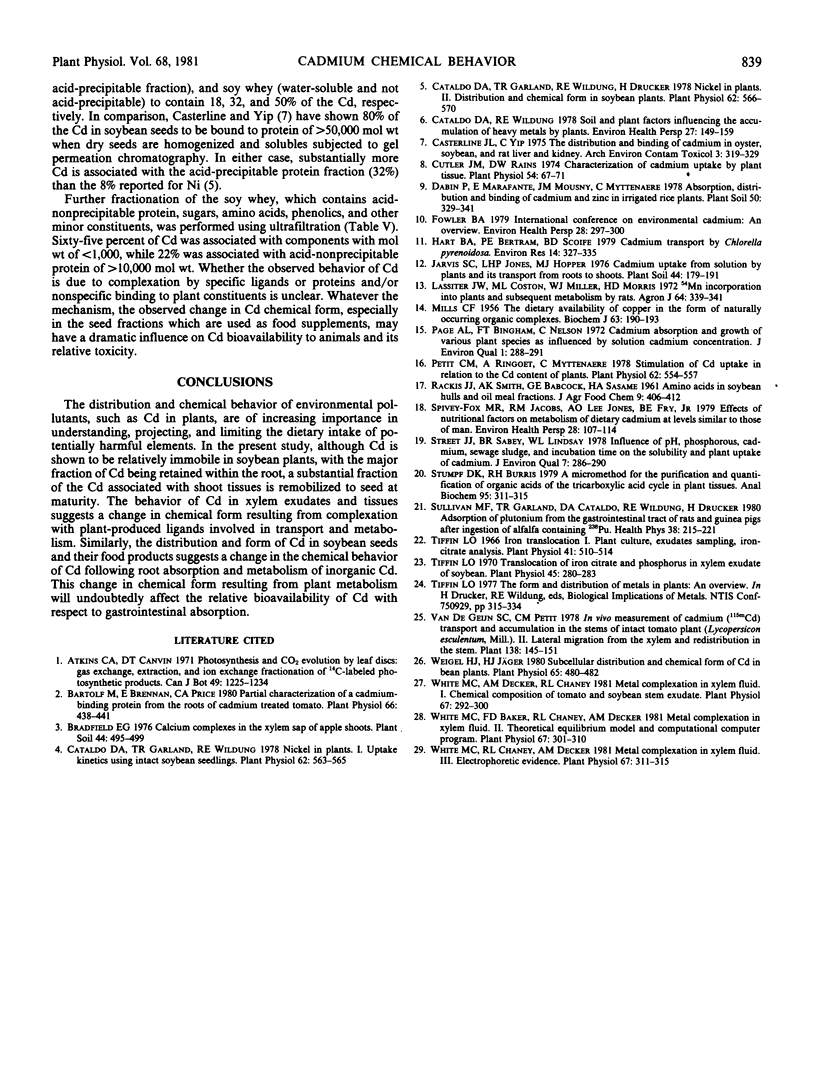
Selected References
These references are in PubMed. This may not be the complete list of references from this article.
- Bartolf M., Brennan E., Price C. A. Partial Characterization of a Cadmium-binding Protein from the Roots of Cadmium-treated Tomato. Plant Physiol. 1980 Sep;66(3):438–441. doi: 10.1104/pp.66.3.438. [DOI] [PMC free article] [PubMed] [Google Scholar]
- Casterline J. L., Jr, Yip G. The distribution and binding of cadmium in oyster, soybean, and rat liver and kidney. Arch Environ Contam Toxicol. 1975;3(3):319–329. doi: 10.1007/BF02220744. [DOI] [PubMed] [Google Scholar]
- Cataldo D. A., Garland T. R., Wildung R. E. Nickel in Plants: II. Distribution and Chemical Form in Soybean Plants. Plant Physiol. 1978 Oct;62(4):566–570. doi: 10.1104/pp.62.4.566. [DOI] [PMC free article] [PubMed] [Google Scholar]
- Cataldo D. A., Garland T. R., Wildung R. E. Nickel in plants: I. Uptake kinetics using intact soybean seedlings. Plant Physiol. 1978 Oct;62(4):563–565. doi: 10.1104/pp.62.4.563. [DOI] [PMC free article] [PubMed] [Google Scholar]
- Cataldo D. A., Wildung R. E. Soil and plant factors influencing the accumulation of heavy metals by plants. Environ Health Perspect. 1978 Dec;27:149–159. doi: 10.1289/ehp.7827149. [DOI] [PMC free article] [PubMed] [Google Scholar]
- Cutler J. M., Rains D. W. Characterization of cadmium uptake by plant tissue. Plant Physiol. 1974 Jul;54(1):67–71. doi: 10.1104/pp.54.1.67. [DOI] [PMC free article] [PubMed] [Google Scholar]
- Fox M. R., Jacobs R. M., Jones A. O., Fry B. E., Jr Effects of nutritional factors on metabolism of dietary cadmium at levels similar to those of man. Environ Health Perspect. 1979 Feb;28:107–114. doi: 10.1289/ehp.7928107. [DOI] [PMC free article] [PubMed] [Google Scholar]
- Hart B. A., Bertram P. E., Scaife B. D. Cadmium transport by Chlorella pyrenoidosa. Environ Res. 1979 Apr;18(2):327–335. doi: 10.1016/0013-9351(79)90109-9. [DOI] [PubMed] [Google Scholar]
- MILLS C. F. The dietary availability of copper in the form of naturally occurring organic complexes. Biochem J. 1956 Jun;63(2):190–193. doi: 10.1042/bj0630190. [DOI] [PMC free article] [PubMed] [Google Scholar]
- Petit C. M. Stimulation of cadmium uptake in relation to the cadmium content of plants. Plant Physiol. 1978 Oct;62(4):554–557. doi: 10.1104/pp.62.4.554. [DOI] [PMC free article] [PubMed] [Google Scholar]
- Stumpf D. K., Burris R. H. A micromethod for the purification and quantification of organic acids of the tricarboxylic acid cycle in plant tissues. Anal Biochem. 1979 May;95(1):311–315. doi: 10.1016/0003-2697(79)90221-5. [DOI] [PubMed] [Google Scholar]
- Sullivan M. F., Garland T. R., Cataldo D. A., Wildung R. E., Drucker H. Absorption of plutonium from the gastrointestinal tract of rats and guinea pigs after ingestion of alfalfa containing 238Pu. Health Phys. 1980 Feb;38(2):215–221. [PubMed] [Google Scholar]
- Tiffin L. O. Iron translocation I. Plant culture, exudate sampling, iron-citrate analysis. Plant Physiol. 1966 Mar;41(3):510–514. doi: 10.1104/pp.41.3.510. [DOI] [PMC free article] [PubMed] [Google Scholar]
- Tiffin L. O. Translocation of iron citrate and phosphorus in xylem exudate of soybean. Plant Physiol. 1970 Mar;45(3):280–283. doi: 10.1104/pp.45.3.280. [DOI] [PMC free article] [PubMed] [Google Scholar]
- Weigel H. J., Jäger H. J. Subcellular distribution and chemical form of cadmium in bean plants. Plant Physiol. 1980 Mar;65(3):480–482. doi: 10.1104/pp.65.3.480. [DOI] [PMC free article] [PubMed] [Google Scholar]
- White M. C. Metal Complexation in Xylem Fluid : I. CHEMICAL COMPOSITION OF TOMATO AND SOYBEAN STEM EXUDATE. Plant Physiol. 1981 Feb;67(2):292–300. doi: 10.1104/pp.67.2.292. [DOI] [PMC free article] [PubMed] [Google Scholar]
- White M. C. Metal Complexation in Xylem Fluid : II. THEORETICAL EQUILIBRIUM MODEL AND COMPUTATIONAL COMPUTER PROGRAM. Plant Physiol. 1981 Feb;67(2):301–310. doi: 10.1104/pp.67.2.301. [DOI] [PMC free article] [PubMed] [Google Scholar]
- White M. C. Metal Complexation in Xylem Fluid : III. ELECTROPHORETIC EVIDENCE. Plant Physiol. 1981 Feb;67(2):311–315. doi: 10.1104/pp.67.2.311. [DOI] [PMC free article] [PubMed] [Google Scholar]


